Abstract
The non-oxidizing antimicrobial 2-Methyl-4-Isothiazolin-3-one (MIT) poses a significant environmental risk given its frequent detection in municipal wastewater. This study showed that the combination of Vacuum UV/UV (VUV/UV) and persulfate (PDS) efficiently achieved the rapid transformation and removal of 10 μM MIT within 90 s, which is much faster than UV, UV/PDS, and VUV/UV. Increasing the PDS dosage improved MIT degradation, whereas changes in pH between 4 and 10 had little effect. Radical quenching experiments showed that 93% of the MIT oxidation was attributable to the hydroxyl radical (•OH) and the sulfate radical (SO4•−). SO4•− and •OH at concentrations of 8.6 × 10−12 M and 1.5 × 10−12 M accounted for 32% and 61% of the MIT degradation, respectively, and the greater contribution of •OH was attributed to its higher reaction rate constant with MIT compared to SO4•−. Sulfate had a negligible impact on the radical concentrations. Chloride (1 mM) reduced the SO4•− and •OH concentrations by 61% and 27%, respectively. And the SO4•− contribution to MIT degradation fell to 19%. Nitrate (5 mM) readily quenched •OH but minimally affected SO4•−. The •OH concentration decreased by 79%, reducing its contribution to 27%. Bicarbonate/carbonate (5 mM) simultaneously reduced the SO4•− and •OH by 26–30% and had little effect on their contributions. Because of the quenching effect of organic matter and inorganic anions on radicals, secondary effluent inhibited the degradation of MIT. After a 120 s treatment, the total organic carbon, UV254, and fluorescence regional integration were reduced by 5%, 8%, and 17–24%, respectively. This study provides a quantitative analysis of how inorganic ions alter the concentrations and contributions of •OH and SO4•−, elucidating the MIT removal mechanisms in VUV/UV/PDS for sustainable wastewater reclamation.
1. Introduction
2-Methyl-4-Isothiazolin-3-one (MIT), a non-oxidizing antimicrobial, is widely used across industries—including papermaking, leather, dye coatings, cosmetics, and reverse osmosis systems—to inhibit the growth of bacteria, fungi, and algae [1,2]. The antimicrobial mechanism of MIT involves reducing the sulfur atom to form a disulfide bond with cysteine, thereby inactivating the protein. Studies have shown that MIT has adverse effects on rat lung macrophages [3], cortical neurons [4], and zebrafish embryos [5] and can also cause skin contact allergies [6]. The environmental risks posed by MIT have become a subject of concern in recent years. Water resource shortages are driving an increased demand for municipal wastewater reclamation. In water-deficient areas, treated wastewater that contains MIT (such as secondary effluent from a wastewater treatment plant) is often used to replenish rivers and lakes [7]. The use of reclaimed water in many cities for street cleaning and landscaping directly increases public exposure to MIT [8]. Since MIT biodegrades slowly in the environment, continuous discharges will inevitably increase its environmental load [9,10]. Therefore, MIT removal is necessary during the wastewater reclamation process to reduce potential environmental and health hazards [11].
A variety of technologies have been studied and applied in MIT processing. The soil filtration method is low-cost but requires a long hydraulic retention time to achieve a high removal rate [12]. Due to its antimicrobial activity, MIT at mg/L levels can inhibit the biological treatment systems [13]. Advanced oxidation processes, such as photocatalytic oxidation and ozonation, can efficiently remove MIT. However, photocatalytic oxidation faces the challenge of catalyst separation and recovery [14]. Ozonation risks forming harmful by-products such as bromate [15].
Compared with established processes, the emerging vacuum UV/UV (VUV/UV) technology shows promise for pollutant removal [16,17]. 185 nm and 254 nm photons can be emitted by the conventional low-pressure mercury lamp. However, the traditional glass tube wall will block 185 nm photons. In contrast, the VUV/UV light source uses a high-permeability quartz tube wall, which can utilize both wavelengths at the same power consumption [18,19]. The 185-nm VUV can also activate H2O molecules to form hydroxyl radicals (•OH). VUV/UV enables the rapid degradation of a broader spectrum of organic pollutants, including many that are refractory to UV alone [20,21].
The VUV/UV/persulfate (VUV/UV/PDS) technology uses VUV, UV, and persulfate to drive superior contaminant removal, further enhancing the removal efficiency. The simultaneous activation of persulfate and H2O by VUV/UV produces large amounts of sulfate radicals (SO4•−) and •OH radicals. The high operational stability and strong adaptability of VUV/UV/PDS make it a very promising candidate for full-scale water treatment applications [22].
Although MIT degradation by 254-nm UV combined with oxidants or catalysts has been reported [23], applications of the VUV/UV light source for MIT removal remain limited [23], and MIT removal by VUV/UV/PDS has not been reported. The technical advantages of VUV/UV/PDS for removing MIT and treating real reclaimed water must be investigated. While inorganic anions in real water matrices are known to reduce MIT removal efficiency, their effects on radical concentrations have not been quantified.
The objective of the study was to explore MIT removal by VUV/UV/PDS under different oxidation conditions and water matrices. The steady-state concentrations and MIT degradation contributions of SO4•− and •OH in the presence of different inorganic anions were quantified. In addition, the efficacy of VUV/UV/PDS for MIT removal from actual secondary effluent was evaluated, along with subsequent changes in total organic carbon, UV254, and three-dimensional fluorescence spectrum.
2. Materials and Methods
2.1. Chemicals and Materials
2-Methyl-4-Isothiazolin-3-one (MIT, 98.0%) was sourced from Xushuo Biotechnology (Shanghai, China). Sodium persulfate (Na2S2O8, 99%) was purchased from SennChem (Shanghai, China). Sodium thiosulfate (Na2S2O3·5H2O, 99%) was purchased from Innochem (Beijing, China). Disodium hydrogen phosphate dodecahydrate (Na2HPO4·12H2O, 99%) was purchased from Jingchun (Beijing, China). Formic acid (99%) was acquired from Alicheem Chemical Technology Co., Ltd. (Shanghai, China). Methanol (chromatographic grade) was obtained from MREDA (Beijing China). Sodium chloride (NaCl) was provided by Sinopharm Chemical Reagent Co., Ltd. (Shanghai, China), sodium nitrate (NaNO3,99.0%) was provided by Alfa Aesar (Shanghai, China), sodium sulfate (Na2SO4, 99%) was provided by Macklin (Shanghai, China), sodium dihydrogen phosphate dihydrate (NaH2PO4·2H2O), ethanol (chromatographic grade, 99.5%), sodium bicarbonate (NaHCO3, 99.8%), p-nitrobenzoic acid (pNBA), p-chlorobenzoic acid (pCBA) were provided by Aladdin (Shanghai, China). The ultrapure water was prepared by Milli-Q ultrapure water device. The actual reclaimed water used was the secondary effluent from a Beijing sewage treatment plant.
2.2. Experimental Procedure
A quasi-collimated VUV/UV system was used. The employed light sources included 254 nm UV lamps and 185 nm + 254 nm VUV/UV lamps, both purchased from Foshan Comwin (Foshan, China). Nitrogen gas is required throughout the experiment to prevent ozone production by VUV reactions with air. A 30-min stabilization period was applied to the device’s VUV and UV irradiance before the start of the experiment. The reaction solution was continuously stirred with a magnetic stirrer throughout the reaction.
A 50-mL solution containing 10 μM of MIT was introduced into the reaction dish, after which the PDS solution at the required concentration was added dropwise. The initial pH was regulated by sodium hydroxide and sulfuric acid. The samples were tested when adjusted. To block 185-nm UV light, filters must be installed in advance when conducting experiments on separate UV and UV-PDS treatment technologies. Before the start of the experiment, the irradiance (3.3 × 103 μEinstein/(cm2·s) and 1.3 × 103 μEinstein/(cm2·s)) of the ultraviolet lamp was gauged using an ILT2400 ultraviolet radiometer (International Light Technologies, Peabody, MA, USA). The secondary effluent was subjected to a 0.45-μm membrane filtration and was amended with MIT to a final concentration of 10 μM. All experiments were performed in at least duplicate.
2.3. Determination of Radical Concentration
Reaction rate constants that associated MIT, pCBA, and pNBA with the •OH radicals were 7.5 × 109 M−1 s−1, 5 × 109 M−1 s−1, and 2.6 × 109 M−1 s−1, respectively. The pNBA did not react with the SO4•− radicals, and the reaction rate of pCBA with the SO4•− radicals was 3.6 × 108 M−1 s−1 [24]. In the mixed solution of MIT, pCBA, and pNBA, the respective degradation kinetics were shown in Equations (1)–(3). Details of the calculation methods were shown in Text S1. The synergistic coefficient for combining VUV/UV and PDS was calculated using Equation (4).
2.4. Analysis Method
The MIT was analyzed by HPLC (Shimadzu, Kyoto, Japan) fitted with a C8 column (250 × 4.6 mm, 5 μm) from J & K Scientific (Beijing, Shanghai). A 1:1 mixture of organic and inorganic phases served as the mobile phase. The organic phase was methanol, and the inorganic phase was a 10 mM phosphate buffer at pH 3 with 0.1% formic acid.
The TOC in the samples before and after the reactions was determined with a TOC analyzer (Sievers 5310 C, Wilmington, DE, USA). The UV254 absorbances of the sample before and after the reactions were measured using an ultraviolet spectrophotometer. The three-dimensional fluorescence spectra of the samples before and after the reactions were measured by the fluorescence spectrophotometer (F-7000, Hitachi, Tokyo, Japan).
3. Results and Discussion
3.1. MIT Removal by VUV/UV/PDS
The curves depicting MIT degradation by different technologies are manifested in Figure S1. The MIT degradation by PDS alone and UV alone was extremely slow, with less than 10% MIT degradation achieved within 90 s. The VUV/UV/PDS, VUV/UV, and UV/PDS processes reached removal efficiencies of 100%, 71%, and 25%, respectively, at 90 s. The synergistic coefficient was >1 throughout the degradation process, indicating a synergistic effect between VUV/UV and PDS.
It is worth noting that the UV and VUV/UV experiments have different intensities. Under the same time condition, the fluence of VUV/UV exceeds that of UV. The time unit was converted to fluence based on the light intensity, as described by Xue et al. [25], to eliminate the effect of different fluences and to ensure that the efficiencies of the techniques could be compared under the same fluence. Following this adjustment (Figure 1), VUV/UV/PDS still showed the best performance on MIT removal [26].
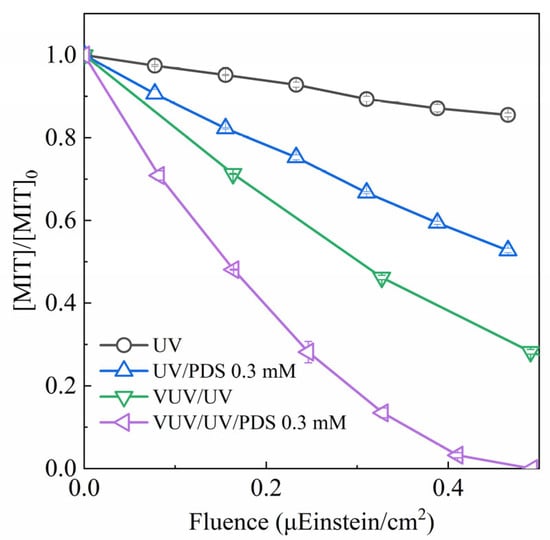
Figure 1.
Degradation of MIT by different technologies.
The MIT degradation achieved by a combined UV/PDS technique showed a synergistic effect, with a degradation rate significantly higher than the sum of the degradation rates from the individual UV and PDS processes under the same conditions. During interactions between UV and PDS, UV can activate PDS and produce strong oxidizing radicals that degrade MIT rapidly [7,26]. The VUV/UV and PDS combination also had a synergistic effect on MIT removal, through PDS activation and the generation of sulfate radicals. Similar findings have also been reported during sulfamethoxazole degradation by schwertmannite with the UV/PDS system [27,28].
The conditions and efficiencies for MIT removal by other treatment technologies are summarized in Table S1. VUV/UV/PDS outperforms UV-based AOPs [7,9], ozonation [15], electro-oxidation [8,29], and microalgal treatment [30], in terms of reaction time and removal efficiency, and its performance is comparable to that of O3/PMS [31]. It should be noted that the experimental conditions across studies vary and may influence treatment outcomes. Future work should conduct more comprehensive technology comparisons from the perspectives of cost-effectiveness and product toxicity.
3.2. Influence of PDS Concentration and pH
3.2.1. Influence of Initial PDS Concentration
The MIT degradation by VUV/UV/PDS at different PDS dosages is portrayed in Figure 2. As the PDS concentration increased, the MIT degradation efficiency by VUV/UV/PDS gradually increased. For 0.1 mM PDS, the removal efficiency surpassed 90% within 90 s. For 0.5 mM PDS, the MIT removal was 100% in 75 s. The MIT degradation adhered to the pseudo-first-order kinetics. The apparent rate rose from 0.023 s−1 to 0.038 s−1 when the initial PDS concentration increased from 0.1 mM to 0.5 mM. Similar Effects of PDS dosage have been mentioned during carbamazepine degradation by VUV/UV/PDS [22].
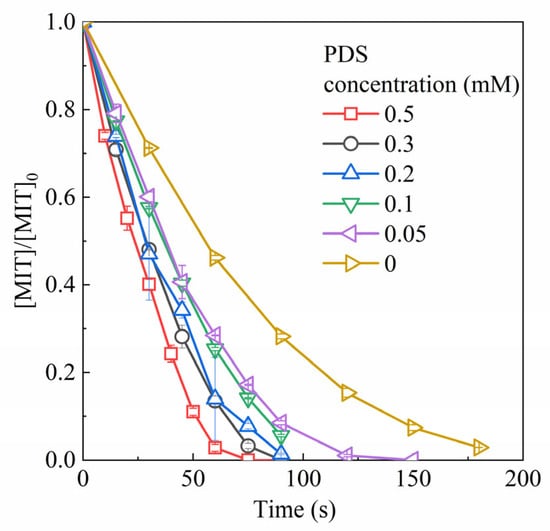
Figure 2.
Effects of PDS concentration on MIT removal by VUV/UV/PDS.
3.2.2. Influence of Initial pH Values
A buffer was not used in this study. The pH values were set using H2SO4 or NaOH before reactions. However, Wu et al. [32] noticed shifts in the solution pH throughout the VUV/UV/PDS process. We therefore evaluated the effects of pH changes during the process. As shown in Figure 3, the MIT degradation remained stable over an initial solution pH range of 4–10. Therefore, the pH had little effect on MIT degradation. MIT and PDS maintain consistent speciation from pH 4 to 9. pH does not affect either the reaction rate between MIT and radicals or the photolysis of PDS [22]. As pH rises, SO4•− may be converted to •OH [7]. Based on the findings in Section 3.3.2, the oxidation contribution of •OH is dominant, so the overall impact of pH remains limited. Comparable findings have been documented in studies on MIT degradation via UV/persulfate [7] and ozonation [15], in which pH showed little influence on degradation efficiency.

Figure 3.
Effects of pH on MIT removal by VUV/UV/PDS.
3.3. Concentration and Contribution of Radicals
3.3.1. Effects of Radical Quencher
Ethanol can quench •OH and SO4•− radicals in the reaction system and was used to assess their contribution to MIT removal. As the ethanol concentration increased, the apparent rate dropped gradually from 0.023 s−1 to 0.00196 s−1. When the ethanol concentration exceeded 10 mM, the degradation rate of MIT did not decrease further, which suggests that the radicals were completely quenched (Figure 4). Based on these results, the contribution ratios of the radical oxidation and photolysis to the MIT degradation were 94% and 6%, respectively.
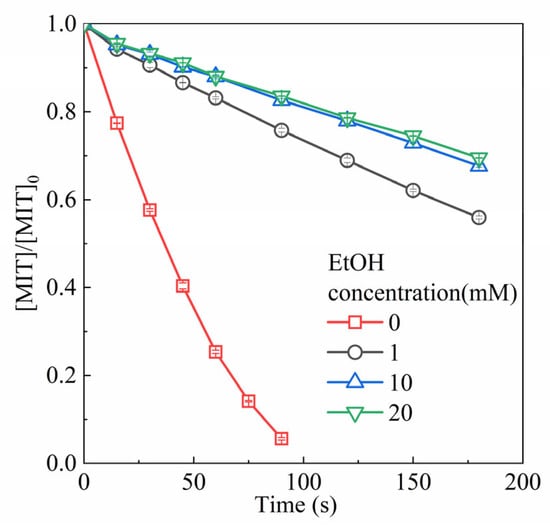
Figure 4.
Effects of ethanol on MIT removal during VUV/UV/PDS.
3.3.2. Concentration of •OH and SO4•−
The •OH and SO4•− radical concentrations during the MIT degradation by VUV/UV/PDS were determined using the pCBA and pNBA probe methods and competitive kinetics. Details of the calculation of concentration and contribution of •OH and SO4•−, and the reaction rate constant of SO4•− to MIT (kMIT, SO4•−) were shown in Figure S2 and Text S1. The kMIT, SO4•− value was computed to be 6.9 × 108 M−1 s−1 (Text S1). In ultrapure water, the VUV/UV/PDS system contained •OH and SO4•− at concentrations of 1.5 × 10−12 M and 8.6 × 10−12 M, respectively. Their respective contributions to degradation accounted for 61% and 32%.
3.4. Effects of Inorganic Anions on Radical Concentration and Degradation Contribution
The presence of inorganic anions in actual water might affect the •OH and SO4•− concentrations, thereby influencing MIT removal. The •OH and SO4•− concentrations in the existence of Cl−, SO42−, NO3−, and HCO3−/CO32− at different concentrations were determined using the pCBA and pNBA probe methods. The contribution ratios of the two radicals to MIT degradation were also calculated.
3.4.1. Chloride
The effect of Cl− on MIT degradation is shown in Figure S4a. The MIT degradation by VUV/UV/PDS was inhibited by Cl−, and the inhibition effect progressively rose with increasing Cl− concentration. At Cl− concentrations of 0 mM, 1 mM, and 10 mM, the 90-s degradation rates of MIT were 100%, 72%, and 48%, respectively. Despite the inhibitory effect of Cl−, it is worth noting that MIT degradation by VUV/UV/PDS with 10 mM Cl− was still higher than that by UV/PDS without Cl− (25%).
When Cl− concentration rose to 1 mM, the •OH concentration dropped by 26% to 1.1 × 10−12 M, while the SO4•− concentration fell by 60% to 3.4 × 10−12 M. The SO4•− concentration was always higher (between 3 and 5.6 times higher) than that of •OH.
As the Cl− concentration rose, the apparent reaction rate constant declined (Figure 5a). Specifically, when the Cl− concentration augmented from 0 mM to 1 mM, the apparent degradation rate dropped from 0.0189 s−1 to 0.0126 s−1.
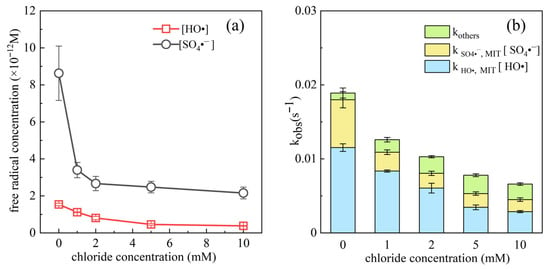
Figure 5.
Effect of chloride on the concentration of sulfate radicals (SO4•−) and hydroxyl radicals (•OH) (a), and their contribution to MIT degradation (b).
Though the concentration of •OH was lower than that of SO4•−, the •OH degradation contribution was higher than that of SO4•− because •OH had a higher reaction rate constant with MIT (7.5 × 109 M−1 s−1) than SO4•− (6.9 × 108 M−1 s−1). When the Cl− concentration increased from 0 mM to 1 mM, the SO4•− contribution dropped from 32% to 19%, while the •OH contribution increased from 62% to 66% (Figure 5b).
With the Cl− addition, the SO4•− reacted with the Cl− (Equation (5)), and the SO4•− concentration decreased sharply, resulting in a decrease of the SO4•− degradation contribution. In contrast, the reaction between Cl− and •OH was reversible (Equations (6) and (7)) and had little effect on the •OH concentration.
VUV/UV/PDS oxidation of methylene blue showed similar effects, where the Cl− consumed most of the SO4•−, reaching 67.5–82.2%, followed by MB (11.4–21.6%) [24]. It can be inferred that, during the MIT treatment with VUV/UV/PDS, chlorides mainly affected the transformation of SO4•− and inhibited the MIT degradation by SO4•−.
3.4.2. Sulfate
The presence of SO42− had little impact on MIT degradation, which is presented in Figure S4b. Similar results were reported during VUV/UV/PDS oxidation of methylene blue [24].
The effects of SO42− on the •OH and SO4•− concentrations are shown in Figure 6a. The addition of SO42− (0–10 mM) to the reaction system led to the conversion of a small amount of •OH to SO4•−, and a slight fluctuation in the apparent rate constant. In the presence of SO42−, the •OH, SO4•−, and photolysis contributions were 36–61%, 32–43%, and 6–28%, respectively (Figure 6b).

Figure 6.
Effect of sulfate on the concentration of SO4•− and •OH (a), and their contribution to MIT degradation (b).
3.4.3. Nitrate
The effect of NO3− on MIT degradation is shown in Figure S4c. Yang et al. [33] observed a drop in MIT degradation after NO3− addition. When the NO3− concentration rose from 0 mM to 1 mM, the degradation rate fell from 90% to 60% in 90 s, and, when the NO3− concentration was 10 mM, the degradation rate was 51% at 90 s.
The effects of NO3− on the •OH and SO4•− concentrations in the reaction system are shown in Figure 7a. When NO3− (0–5 mM) was added to the reaction system, there was no noticeable change in the SO4•− concentration, but the •OH concentration decreased significantly. A rise in NO3− concentration from 0 mM to 1 mM led to a 62% reduction in •OH concentration, which fell from 1.5 × 10−12 M to 5.7 × 10−13 M. When the NO3− concentration increased from 0 mM to 5 mM, the SO4•− degradation contribution changed from 32% to 71%, and the •OH degradation contribution decreased from 61% to 27% (Figure 7b).
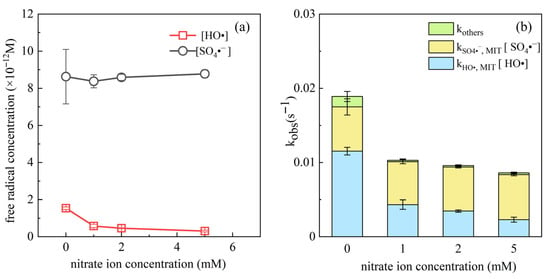
Figure 7.
Effects of nitrate on the concentration of SO4•− and •OH (a), and their contribution to MIT degradation (b).
Studies have shown that NO3− can inhibit the degradation of pollutants in UV photolysis and UV-based AOPs. It has been reported that NO3− can compete with pollutants to consume • OH, hydrogen atoms, and electrons [34,35], resulting in a decrease in the •OH concentration and degradation contribution, and little change in the SO4•− concentration.
3.4.4. Bicarbonate/Carbonate
The effects of bicarbonate/carbonate (HCO3−/CO32−), common anions in wastewater and natural water, on MIT degradation by VUV/UV/PDS are presented in Figure S4d. As the HCO3−/CO32− concentration grew, the MIT degradation rate gradually fell. At a concentration of 10 mM, the degradation rate at 90 s was 32%.
The addition of HCO3−/CO32− significantly reduced the SO4•− and •OH concentrations (Figure 8a). When HCO3−/CO32− concentrations rose to 10 mM, the SO4•− concentrations dropped by 79% to 1.8 × 10−12 M, and the •OH concentrations dropped by 82% to 2.7 × 10−13 M. The apparent reaction rate constant of MIT degradation decreased, and there were no obvious patterns in the degradation contributions of each part. The SO4•−, •OH, and photolysis contributions were 30–37%, 53–61%, and 7–15%, respectively, as shown in Figure 8b.
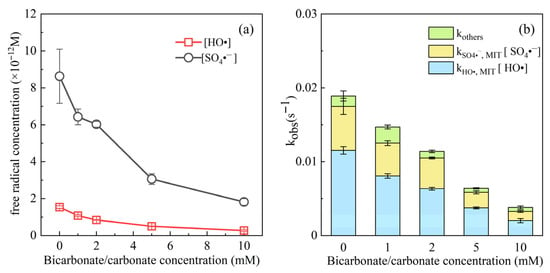
Figure 8.
Effects of bicarbonate/carbonate on the concentration of SO4•− and •OH (a) and their contribution to MIT degradation (b).
HCO3−/CO32− can react rapidly with •OH and SO4•− [36,37]. Wen et al. [24] documented that the HCO3−/CO32− reaction rate constants with •OH and SO4•− ranged from 8.5 × 106–3.9 × 108 M−1 s−1, and 1.6 × 106–6.1 × 106 M−1 s−1, respectively. Therefore, HCO3−/CO32−, when present, inhibited MIT removal during VUV/UV/PDS oxidation.
3.5. MIT Removal in Actual Secondary Effluent
3.5.1. Removal of MIT, TOC and UV254
In actual secondary effluent, the MIT degradation by VUV/UV/PDS was inhibited. The degradation rate was 16% at 90 s (Figure 9). The low rate may have been due to various anions in the secondary effluent, which competitively absorbed UV light and quenched radicals, thereby decreasing the degradation rate of MIT.
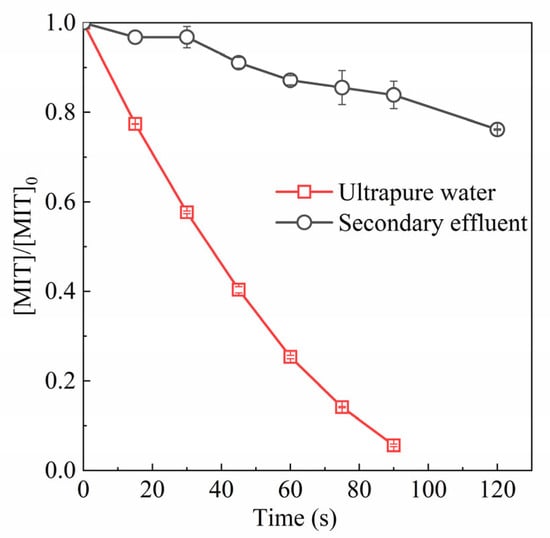
Figure 9.
MIT removal by VUV/UV/PDS in actual secondary effluent.
The TOC and UV254 were determined before and after the VUV/UV/PDS oxidation. The TOC concentration was 5% lower after the reaction than before. The slight difference may reflect the short reaction time, during which there was minimal mineralization of pollutants by VUV/UV/PDS. The UV254 was 8% lower after the reaction than before, indicating that some aromatic C=C and C=O bonds were removed in the secondary effluent.
3.5.2. The Three-Dimensional Fluorescence Spectrum
A five-point method was used to divide the three-dimensional fluorescence region [38]. The fluorescence of the samples was detected before and after 120 s of treatment (Figure 10). The fulvic acid, humic acid, and soluble microbial product concentrations in the secondary effluent were higher than those in the spiked MIT solution. The fluorescence intensity in II, III, IV, and V decreased after the VUV/UV/PDS treatment.
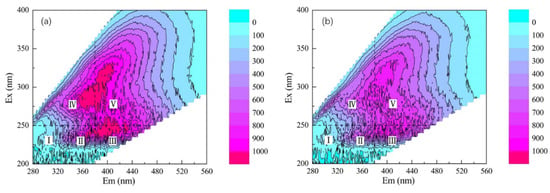
Figure 10.
The three-dimensional fluorescence spectrum without treatment (a) and after 120 s of VUV/UV/PDS treatment (b). I and II: aromatic proteins; III: fulvic acid substances; IV: soluble microbial products; V: humic acid substances.
The fluorescence intensity of the five regions was integrated separately. The changes in the fluorescence regional integration are shown in Figure S3. After 120 s of VUV/UV/PDS treatment, the fluorescence regional integrations of I, II, III, IV, and V were 24%, 23%, 18%, 21%, and 17% lower than at the start of the reaction, respectively. The reduction differences in each region were similar, indicating that the VUV/UV/PDS treatment technology had a general ability to degrade most organic matter in secondary effluent.
4. Conclusions
VUV/UV/PDS showed synergistic performance on MIT removal. The degradation reaction was dominated by radical oxidation. Enhancing PDS dosage promoted MIT degradation, while the effects of pH values (4–10) are slight.
Under UPW conditions, the SO4•− concentration during MIT degradation by VUV/UV/PDS is 5.7-fold that of •OH. Because •OH reacts with MIT 10.9 times faster than SO4•− does, •OH governs MIT removal. Actual secondary effluents contain various inorganic ions that scavenge radicals, altering radical concentrations and thereby inhibiting MIT degradation. This study provides a quantitative analysis of how inorganic ions alter both the concentration and contribution of •OH and SO4•−.
Sulfate had a negligible effect on radical concentration and MIT degradation. Chloride significantly reduced SO4•− concentration and moderately reduced the •OH concentration. Nitrate significantly reduced the •OH concentration but had little effect on SO4•−. In the presence of 5 mM nitrate, MIT degradation switched to SO4•− domination. Bicarbonate/carbonate decreased both •OH and SO4•− concentrations and had little effect on their contributions.
Removing MIT using VUV/UV/PDS during wastewater reclamation processes can reduce risks associated with the ecological use of reclaimed water, address the drying up of rivers and lakes in water-scarce regions, and directly support the long-term goals of water recycling and sustainable urban development. Although this study has shown advantages in MIT removal using VUV/UV/PDS, several limitations remain to be addressed. Firstly, the operating costs have not been systematically evaluated to clarify the economic feasibility of large-scale application. It is necessary to construct a pilot continuous-flow system to simulate performance and conduct a cost-effectiveness analysis. Research on the degradation products and changes in toxicity still needs to be deepened, and the whole life cycle and carbon footprint assessments need to be carried out.
Supplementary Materials
The following supporting information can be downloaded at: https://www.mdpi.com/article/10.3390/su17219882/s1, Figure S1: The degradation performances of MIT by UV alone, PDS alone, UV/PDS, VUV/UV and VUV/UV/PDS; Figure S2: MIT logarithmic degradation curves of pCBA and pNBA as radical probes; Figure S3: The change of fluorescence intensity in each region before and after degradation; Figure S4: Effect of anions on degradation of MIT by VUV/UV/PDS. (a) Cl−, (b) SO42−, (c) NO3−, and (d) HCO3−/CO32−; Table S1: Removal of MIT by different treatment processes; Text S1: Calculation of the steady-state concentration of sulfate radicals (SO4•−), hydroxyl radicals (•OH), the second order rate constant between MIT and SO4•− (kMIT, SO4•−), and the contributions of radicals.
Author Contributions
Conceptualization, N.H.; Formal analysis, Y.-F.Z. and H.-W.X.; Funding acquisition, N.H.; Investigation, Y.-F.Z. and H.-W.X.; Methodology, H.-W.X.; Supervision, N.H.; Writing—original draft, Y.-F.Z.; Writing—review & editing, N.H. All authors have read and agreed to the published version of the manuscript.
Funding
This study was funded by the Major Program of National Natural Science Foundation of China (No. 52293440, No. 52293442) and the National Natural Science Foundation of China (No. 52100051).
Institutional Review Board Statement
Not applicable.
Informed Consent Statement
Not applicable.
Data Availability Statement
The original contributions presented in this study are included in the article/Supplementary Material. Further inquiries can be directed to the corresponding author.
Conflicts of Interest
The authors declare no conflicts of interest. The funders had no role in the design of the study; in the collection, analyses, or interpretation of data; in the writing of the manuscript; or in the decision to publish the results.
References
- Bollmann, U.E.; Vollertsen, J.; Carmeliet, J.; Bester, K. Dynamics of biocide emissions from buildings in a suburban stormwater catchment-Concentrations, mass loads and emission processes. Water Res. 2014, 56, 66–76. [Google Scholar] [CrossRef]
- Carbajo, J.B.; Perdigón-Melón, J.A.; Petre, A.L.; Rosal, R.; Letón, P.; García-Calvo, E. Personal care product preservatives: Risk assessment and mixture toxicities with an industrial wastewater. Water Res. 2015, 72, 174–185. [Google Scholar] [CrossRef] [PubMed]
- Poon, R.; Rigden, M.; Edmonds, N.; Charman, N.; Lamy, S. EVects of 5-chloro-2-methyl-4-isothiazolin-3-one and other candidate biodiesel biocides on rat alveolar macrophages and NR8383 cells. Arch. Toxicol. 2011, 85, 1419–1427. [Google Scholar] [CrossRef] [PubMed]
- He, K.; Huang, J.; Lagenaur, C.F.; Aizenman, E. Methylisothiazolinone, a neurotoxic biocide, disrupts the association of Src family tyrosine kinases with focal adhesion kinase in developing cortical neurons. J. Pharmacol. Exp. Ther. 2006, 317, 1320–1329. [Google Scholar] [CrossRef]
- Li, A.; Chen, Z.; Wu, Q.Y.; Huang, M.H.; Liu, Z.Y.; Chen, P.; Mei, L.C.; Hu, H.Y. Study on the removal of benzisothiazolinone biocide and its toxicity: The effectiveness of ozonation. Chem. Eng. J. 2016, 300, 376–383. [Google Scholar] [CrossRef]
- Marrero-Alemán, G.; Santana, P.S.; Liuti, F.; Hernández, N.; López-Jiménez, E.; Borrego, L. The Role of Cleaning Products in Epidemic Allergic Contact Dermatitis to Methylchloroisothiazolinone/Methylisothiazolinone. Dermatitis 2018, 29, 77–80. [Google Scholar] [CrossRef]
- Cui, J.Z.; Cai, S.K.; Zhang, S.R.; Wang, G.Q.; Gao, C.Z. Degradation of a non-oxidizing biocide in circulating cooling water using UV/persulfate: Kinetics, pathways, and cytotoxicity. Chemosphere 2022, 289, 133064. [Google Scholar] [CrossRef]
- Wang, Y.C.; Chen, M.; Wang, C.; Meng, X.Y.; Zhang, W.Q.; Chen, Z.F.; Crittenden, J. Electrochemical degradation of methylisothiazolinone by using Ti/SnO2-Sb2O3/α, β-PbO2 electrode: Kinetics, energy efficiency, oxidation mechanism and degradation pathway. Chem. Eng. J. 2019, 374, 626–636. [Google Scholar] [CrossRef]
- Chai, Z.Z.; Wang, J.Q.; Dai, Y.X.; Du, E.R.; Guo, H.G. Synergy between UV light and trichloroisocyanuric acid on methylisothiazolinone degradation: Performance, kinetics and degradation pathway. Environ. Res. 2023, 236, 116693. [Google Scholar] [CrossRef]
- Gómez-Rodríguez, P.; Calza, P.; Fabbri, D.; Medana, C.; van-Grieken, R.; López-Muñoz, M.J. Photocatalytic degradation of methylisothiazolinone in water by TiO2 and TiO2/persulfate systems with simulated solar radiation. Catal. Today 2023, 413, 113942. [Google Scholar] [CrossRef]
- López-Timoner, R.; Duarte-Alvarado, V.; Castillo, M.A.; Santos-Juanes, L.; Arques, A.; Amat, A.M. Parabens and Methylisotiazolinone (MIT): Preservatives with Different Behaviors When Subjected to Ozone and Ultraviolet Light Treatments. Water 2023, 15, 3837. [Google Scholar] [CrossRef]
- Bester, K.; Banzhaf, S.; Burkhardt, M.; Janzen, N.; Niederstrasser, B.; Scheytt, T. Activated soil filters for removal of biocides from contaminated run-off and waste-waters. Chemosphere 2011, 85, 1233–1240. [Google Scholar] [CrossRef]
- Laopaiboon, L.; Laopaiboon, P. Biodegradation of isothiazolone biocide (Kathon WT) and treatment efficiency in a laboratory-scale rotating biological contactor. J. Biotechnol. 2010, 150, S227. [Google Scholar] [CrossRef]
- Kandavelu, V.; Kastien, H.; Thampi, K.R. Photocatalytic degradation of isothiazolin-3-ones in water and emulsion paints containing nanocrystalline TiO2 and ZnO catalysts. Appl. Catal. B-Environ. Energy 2004, 48, 101–111. [Google Scholar] [CrossRef]
- Li, A.; Wu, Q.Y.; Tian, G.P.; Hu, H.Y. Effective degradation of methylisothiazolone biocide using ozone: Kinetics, mechanisms, and decreases in toxicity. J. Environ. Manag. 2016, 183, 1064–1071. [Google Scholar] [CrossRef]
- Zheng, X.; Yang, Q.; Xia, J.; Cheng, R.; Li, H.; Zheng, J. Resistance differences of representative model microorganisms in different disinfection processes: ZIF-67, UVC and ozone. Water Cycle 2024, 5, 259–265. [Google Scholar] [CrossRef]
- Li, M.K.; Wang, C.; Yau, M.L.; Bolton, J.R.; Qiang, Z.M. Sulfamethazine degradation in water by the VUV/UV process: Kinetics, mechanism and antibacterial activity determination based on a mini-fluidic VUV/UV photoreaction system. Water Res. 2017, 108, 348–355. [Google Scholar] [CrossRef] [PubMed]
- Huang, N.; Shao, W.-T.; Wang, Q.; Wang, W.-L.; Wu, Q.-Y.; Hu, H.-Y. Degradation of chloromethylisothiazolinone antimicrobial by Vacuum-Ultraviolet/Ultraviolet irradiation: Reactive species, degradation pathway and toxicity evaluation. Chemosphere 2022, 302, 134821. [Google Scholar] [CrossRef] [PubMed]
- Liu, J.; Bai, X.; Bai, Y. Exploration and case analysis of treatment processes and reuse pathways for industrial brine wastewater in China. Water Cycle 2024, 5, 278–285. [Google Scholar] [CrossRef]
- Li, M.K.; Qiang, Z.M.; Hou, P.; Bolton, J.R.; Qu, J.H.; Li, P.; Wang, C. VUV/UV/Chlorine as an Enhanced Advanced Oxidation Process for Organic Pollutant Removal from Water: Assessment with a Novel Mini-Fluidic VUV/UV Photoreaction System (MVPS). Environ. Sci. Technol. 2016, 50, 5849–5856. [Google Scholar] [CrossRef]
- Xiao, Z.-Y.; Huang, N.; Wang, Q.; Wang, W.-L.; Wu, Q.-Y.; Hu, H.-Y. Advanced oxidation of dodecyl dimethyl benzyl ammonium chloride by VUV/UV/chlorine: Synergistic effect, radicals, and degradation pathway. Sep. Purif. Technol. 2022, 292, 121012. [Google Scholar] [CrossRef]
- Nong, Y.J.; Zhang, Y.L.; Hübner, U.; Wang, W.L.; Wu, Q.Y.; Huang, N.; Drewes, J.E.; Hu, H.Y. Roles of radical species in vacuum-UV/UV/peroxydisulfate advanced oxidation processes and contributions of the species to contaminant degradation at different water depths. J. Hazard. Mater. 2023, 446, 130660. [Google Scholar] [CrossRef] [PubMed]
- Huang, N.; Shao, W.-T.; Wang, W.-L.; Wang, Q.; Chen, Z.-Q.; Wu, Q.-Y.; Hu, H.-Y. Removal of methylisothiazolinone biocide from wastewater by VUV/UV advanced oxidation process: Kinetics, mechanisms and toxicity. J. Environ. Manag. 2022, 315, 115107. [Google Scholar] [CrossRef] [PubMed]
- Wen, D.; Li, W.T.; Lv, J.R.; Qiang, Z.M.; Li, M.K. Methylene blue degradation by the VUV/UV/persulfate process: Effect of pH on the roles of photolysis and oxidation. J. Hazard. Mater. 2020, 391, 121855. [Google Scholar] [CrossRef]
- Xue, H.H.; Gao, S.Y.; Li, M.; Wang, Y.; Liu, B.S. Performance of ultraviolet/persulfate process in degrading artificial sweetener acesulfame. Environ. Res. 2020, 188, 109804. [Google Scholar] [CrossRef]
- Lou, F.; Qiang, Z.M.; Zou, X.; Lv, J.R.; Li, M.K. Organic pollutant degradation by UV/peroxydisulfate process: Impacts of UV light source and phosphate buffer. Chemosphere 2022, 292, 133387. [Google Scholar] [CrossRef]
- Li, G.; Li, H.; Zhang, S.; Mi, X.; Guo, Y.; Song, Z.; Liu, Y.; Pan, H.; Wang, B.; Liu, Y.; et al. Effect of confined Mn oxides on regulating capability of activated coke for persulfate-based oxidation of a sweetener acesulfame. Water Cycle 2024, 5, 247–258. [Google Scholar] [CrossRef]
- Yan, S.; Zhan, L.L.; Meng, X.Q.; Wang, D.A.Z.; Wang, X.M.; Zheng, G.Y.; Lu, J.H.; Zhou, L.X. Role of schwertmannite or jarosite in photocatalytic degradation of sulfamethoxazole in ultraviolet/peroxydisulfate system. Sep. Purif. Technol. 2021, 274, 118991. [Google Scholar] [CrossRef]
- Li, C.F.; Peng, S.Q.; Li, H.Q.; Zhang, M.Y.; Yang, P. Methylisothiazolinone (MIT) degradation performance of an air-lift moving bed electro-Fenton reactor: Homogeneous and heterogeneous phases. Sep. Purif. Technol. 2025, 378, 134768. [Google Scholar] [CrossRef]
- Wang, X.X.; Wang, W.L.; Dao, G.H.; Xu, Z.B.; Zhang, T.Y.; Wu, Y.H.; Hu, H.Y. Mechanism and kinetics of methylisothiazolinone removal by cultivation of Scenedesmus sp. LX1. J. Hazard. Mater. 2020, 386, 121959. [Google Scholar] [CrossRef]
- Yang, Z.W.; Wang, W.L.; Lee, M.Y.; Wu, Q.Y.; Guan, Y.T. Synergistic effects of ozone/peroxymonosulfate for isothiazolinone biocides degradation: Kinetics, synergistic performance and influencing factors*. Environ. Pollut. 2022, 294, 118626. [Google Scholar] [CrossRef] [PubMed]
- Wu, Z.D.; Yang, L.X.; Tang, Y.B.; Qiang, Z.M.; Li, M.K. Dimethoate degradation by VUV/UV process: Kinetics, mechanism and economic feasibility. Chemosphere 2021, 273, 129724. [Google Scholar] [CrossRef] [PubMed]
- Yang, L.X.; Zhang, Z.H.; Chen, Z.M. Formation of nitrite and ammonium during the irradiation of nitrate-containing water by VUV/UV. J. Water Process Eng. 2021, 40, 101801. [Google Scholar] [CrossRef]
- Mack, J.; Bolton, J.R. Photochemistry of nitrite and nitrate in aqueous solution: A review. J. Photochem. Photobiol. A-Chem. 1999, 128, 1–13. [Google Scholar] [CrossRef]
- Zoschke, K.; Dietrich, N.; Börnick, H.; Worth, E. UV-based advanced oxidation processes for the treatment of odour compounds: Efficiency and by-product formation. Water Res. 2012, 46, 5365–5373. [Google Scholar] [CrossRef] [PubMed]
- Li, J.Y.; Jing, B.Q.; Tian, Y.; Li, G.H.; Li, X.K. Electrochemical activation of peroxymonosulfate with commercial electrodes in the mixed reaction chamber: A cost-effective way for sulfamethazine degradation. Desalination Water Treat. 2025, 323, 101279. [Google Scholar] [CrossRef]
- Lee, J.; von Gunten, U.; Kim, J.-H. Persulfate-Based Advanced Oxidation: Critical Assessment of Opportunities and Roadblocks. Environ. Sci. Technol. 2020, 54, 3064–3081. [Google Scholar] [CrossRef]
- Zhang, W.C.; Zhang, Y.J.; Yu, L.J.; Gu, L.K.; Ji, J.T.; Zhang, G.Y.; Peng, Z.X. The effect of nano-Fe3O4 addition on the nitrogen transfer pathways and biomass morphology in floc-granule coexistence system. J. Environ. Chem. Eng. 2024, 12, 114831. [Google Scholar] [CrossRef]
Disclaimer/Publisher’s Note: The statements, opinions and data contained in all publications are solely those of the individual author(s) and contributor(s) and not of MDPI and/or the editor(s). MDPI and/or the editor(s) disclaim responsibility for any injury to people or property resulting from any ideas, methods, instructions or products referred to in the content. |
© 2025 by the authors. Licensee MDPI, Basel, Switzerland. This article is an open access article distributed under the terms and conditions of the Creative Commons Attribution (CC BY) license (https://creativecommons.org/licenses/by/4.0/).